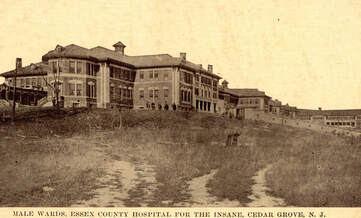
By M.P. Pellicer | Stranger Than Fiction Stories
The end of 1909 was fast approaching when charges were levied against the the County Hospital for the Insane at Overbrook. What started as a miscommunication spawned an investigation that revealed graft, mismanagement and a possible murder. 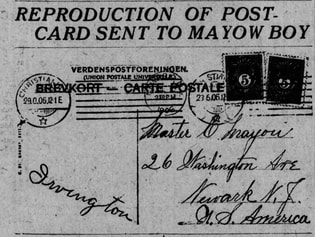 Mrs Mayow produced a post card we showed that even if Newark was used in the address it would reach her in Irvington c.1909 Mrs Mayow produced a post card we showed that even if Newark was used in the address it would reach her in Irvington c.1909
December 1, 1909 Newark, New Jersey
Mary Ann Mayow and Sophia Kiesewetter's mother had been in inmate of an insane asylum for thirty years. The family went to see her every visiting day until she was removed to the Overbrook about 6 years before. They had not gone more often because their mother was unable to recognize them, however they called every month to check on her. In November, 1909, is when they were told that she died August 3, and was buried the next day in a potter's field. The sisters insisted that the officials had their names and addresses on record, and that as of two weeks before, they were told she was alive. It was only after they pressed the matter that the hospital authorities admit they didn't have a record of Mrs. Bauer having been in the asylum at all. Before then they told her family "she's doing fine" and that she was "about the same as before." Mrs. Mayow's address was 29 Washington Avenue, Irvington and Sophia Kiesewetter's was 183 Clinton Avenue in Newark. This might seem unimportant, but the authorities later claimed they had neither address on the patient's records. Then they said Mrs. Mayow had said her address was in Newark, when it was in Irvington, which is why the notice didn't reach her. The sisters complained that for weeks they were told their mother was alive, when in truth she was buried in a potter's field. The family had set aside a plot for her in Clinton Cemetery, well before her death. Mary Ann Mayow filled out an affidavit refuting what the officials said. She said 26 Washington Street had been their home for the last 14 years, and her husband had been working for the post office for the same amount of time. They would have been notified of a wrongly addressed piece of mail, and it would have reached them. Dr. McCormick who was in charge of the ward said: Mary Anne Bauer, a long time patient here died on August 3 of pneumonia. On her death we looked up the records and found an address, 26 Washington St., Newark. Our records showed that none of the relatives of the patient had visited her in two years, and when we got no response from the Washington Street address, the body was turned over to an undertaker for burial. We knew nothing more of the case until yesterday, when Mrs. Mayow of 26 Washington Ave, Irvington called up and asked about her mother. 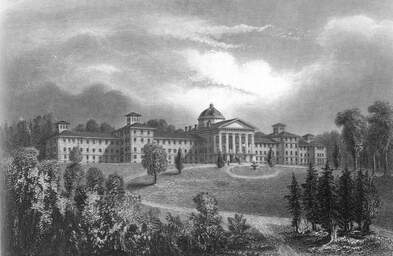 The Essex County Hospital Center, also known as the Overbrook Hospital was built in 1896 on 90 acres to relieve overcrowding at Newark Hospital The Essex County Hospital Center, also known as the Overbrook Hospital was built in 1896 on 90 acres to relieve overcrowding at Newark Hospital
Dr. Daniel M. Dill who was in charge of the asylum could not be reached. The reason, most probably being that this story about the missing Mrs. Bauer, coincided with the recent discovery of a skeleton of an unidentified woman in the attic of the former Essex County Insane Asylum.
A family friend of the sisters had gone to the asylum to see another patient, while there she looked for Mrs. Bauer but had been unable to find her. She was the one who told the daughters to contact the asylum, which is when they were told she had died on August 3. Due to the mistakes exposed by the Bauer case, a rigid overhauling of the system of keeping records at the Overbrook Asylum for the Insane was to be started at once. During an examination of the records it was found there was absolutely no complete record of the total number of patients in the hospital. Dr. Dill insisted that any discrepancies in the records were owing to a fire at the old Camden Street hospital 30 years before. 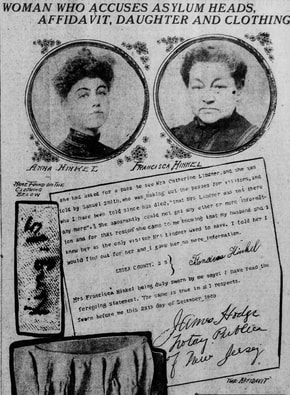 Fannie Hinkel signed an affidavit describing the murder of an inmate Fannie Hinkel signed an affidavit describing the murder of an inmate
Things didn't get better for Dr. Dill when detectives started to investigate the charred skeleton found at the abandoned South Orange Ave asylum (Old Essex County Asylum) on November 8, 1909. Later it was thought to belong to an unrecorded patient named Catherine "Kittie" Littner (Lindner). This scandal worried the freeholders of the asylum the most.
It was said her history was undocumented, since the former superintendent failed to properly transcribe the records of the patients who were transferred from the Camden Street Asylum, to the now abandoned South Orange Avenue institution. But this mystery woman was not the only one without a history of her identity, her diagnosis and treatment plan. It was discovered that 40 patients were removed from the old Camden Street institution to the South Orange Avenue institution, without any record of their cases. The skeleton found was determined to belong to a woman of about 50 years of age, and that she had been dead from five to ten years. They knew it was left there after 1894 when the building was wired for electricity, and the electrical contractors did not find anything there. Another theory was that if no female patient was unaccounted for, than the skeleton must belong to a visitor at the institution. A third possibility was the remains belonged to a patient who escaped, and returned to the place where she was found. The asylum already had a taste of scandal a few years before. The prior superintendent, Dr. Hinckley was accused of having taken home a patient named Catherine Deis. When he quit working at the hospital, he took her and made her a maid at this house for the next 30 years. He claimed he had given her a better life then if she would have stayed in the asylum. Another story came from Franciska "Fannie" Hinkel as to the fate of Catherine Lindner. The affidavit she signed described the following which occurred on February 25, 1904: "My daughter, Anna Hinkel entered the Essex County Hospital for the Insane on November 4, 1903 and my husband who is now dead, and I , did not see her until February, 1904. We saw her for the first time on February 21 after we had been informed by a nurse at the hospital that our daughter had been ill-treated. We found her with her head split open and after some delay got permission to take her out of the hospital on parole. 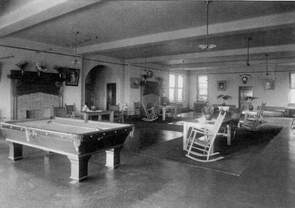 Dayroom at Overbrook c.early 1900s Dayroom at Overbrook c.early 1900s
What had brought Annie Hinkel to the asylum was that in April, 1908, she had disappeared. She left home to visit friends but never arrived there. She had a history of an unsound mind.
But what her mother witnessed confirmed that taking her away was the best course of action. Mrs. Hinkel described where she saw a nurse pull Catherine Lindner who she knew as "Kittie" into the ward by the hair and when she resisted, called two more nurses and a woman patient and the four took her to the room of one of the nurses. They threw her on the floor. One of the nurses sat on her, one held her feet and the woman patient held her arms over head on instruction from one of the nurses. Then one of the nurses picked up a chair in the room, and struck the Lindner woman across the head. She continued her story: I saw blood flow from her nose, ears and mouth and before a second blow could fall I had hold of the chair, telling the nurse to be ashamed of herself and that it was no wonder my daughter had told me she had received the same treatment when she saw the trouble start, and had asked me to leave the ward with her. 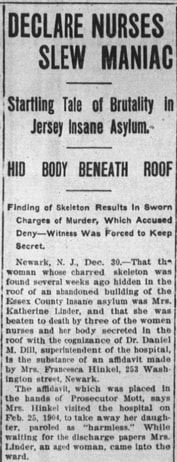 Headlines from Dec. 30, 1909 from the scandal of burned skeleton found in the attic of the abandoned asylum Headlines from Dec. 30, 1909 from the scandal of burned skeleton found in the attic of the abandoned asylum
Mrs. Hinkel then went to both cemeteries mentioned by the nurse, and asked if anyone from the asylum had been sent over to be buried and they said no.
Fannie Hinkel said that Mrs. Lindner had a friend named Mrs. Carl who lived on Camden St. When Mrs. Carl went to visit Catherine at the asylum, she was told by Samuel Smith who was making out the passes for visitors that Mrs. Lindner was not there any more. Dr. Dill was described as a man in a daze who would only say, "I don't know how it happened. I have no information on the subject." It was inevitable that Dr. Daniel M. Dill as head of the County Hospital for the Insane, while not charged with willful neglect, was found to be incompetent by a November grand jury, since the records kept were so defective and imperfect as to be almost valueless. Eventually it was found that Catherine Lindner was in the hospital as late as the early part of 1904 where she was transferred from ward 1 to ward 10, which was the violent ward and within easy access of the attic where the burned skeleton was found. Further into the investigation, it came out the person who had signed on behalf of Dr. Dill to transfer Catherine Lindner from ward 1 to ward 10, was a man who had previously been a patient in the asylum before 1904. He was discharged as cured and then hired as an employee. He recalled signing a card for Catherine Lindner, however her name did not appear on the hospital records. Before the year was out the newspapers printed the story that Catherine Linder (Lindner) a maniac was killed by 3 nurses and with secreted in the roof with the "cognizance of Dr. Daniel M. Dill". The name of the nurse who hit the Lindner across the head was Grace Brush. Dr. Dill insisted Catherine Lindner never existed and was a creation of Mrs. Hinkel.
In another example of poor management, on December 8, 1909 it was revealed that on July 29 relatives of Virginia E. Hogan, 63, who had been at the asylum for 3 months, received a telegram saying she was dead. Later the same day another telegram, this one signed by Dr. Dill, reached the relatives saying that a mistake had been made, and that Mrs. Hogan was not dead. The family, prior to the second telegram had made arrangements to claim the body. Virginia Hogan's sister said her sibling had been sent to the old South Orange Avenue Asylum on May 22, by request of her son Russell Hogan, and the rest of the family knew nothing of the matter until she was in the asylum. They had visited frequently, and the last time in July they were not allowed admission since Dr. Stiles said Mrs. Hogan was worse. This was the same Dr. Stiles that Mrs. Hinkel told police in 1908, had been pursuing her daughter Annie. The undertaker who had gone to the hospital to pick up the body had to hunt around for a long time, and ask a lot of people for information, until they found a body in the basement with a name tag of "Hogan Caldwell" on it. When he asked about the body, he was told it was not the one he came for and they had notified the wrong family. 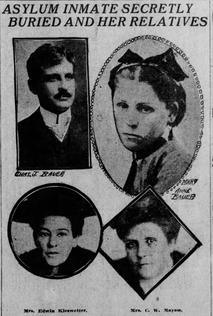 Bauer siblings with a photo of their mother Mary Anne Bauer c.1909 Bauer siblings with a photo of their mother Mary Anne Bauer c.1909
In the meantime Ann Duffy, 88, died at the asylum on December 11, 1909. She had been an inmate since 1881, and was formerly well known in many sections of Newark. There was no record at the asylum of her relative's names. Under the former conditions she would have been buried in the potter's field, however when the news of her death was published, relatives from Brooklyn came to the undertaking rooms of Charles F. Hellman, with the information that they had a plot in Woodland Cemetery, and wanted the body buried there.
Another serious error found while the records were being reviewed, was that a physician signed commitment papers as the patient, instead of the actual patient. The more the investigation dug into the asylum, the worse it looked as to the mismanagement of the Essex County Hospital for the Insane. It was reported that 22 inmates were unaccounted for, and there were 20 inmates of which there was no record on the books. Two patients who had been reported dead were found alive, and the name of a woman long since dead was found in the census as alive. There were patients of which there was no record whatsoever. This gave rise to the possibility that there were people in the asylum who were sane. The system or lack thereof for running the hospital did not prevent unscrupulous persons, with the aid of unscrupulous physicians, to commit to the asylum persons who were sane. Dill might be dazed but he stated that he had no intention of resigning. However a chief justice said to the December grand jury that "if it is proved that the woman who skeleton was found met a violent death those responsible for the death might be indicted for murder." If things could get worse for Dr. Dill they did on December 22, 1909 when a young woman was informed her father had died in the South Orange Avenue Insane Asylum. She had the body brought home only to discover it was not her father, and she found him alive in the asylum. Another man told the newspapers that on June 1, 1879, his wife Mary Coffey was admitted to the old hospital in Camden Street, and she was discharged on April 30, 1882. In 1905, he received a slip of paper signed by Dr. Daniel A. Dill that "Mary Coffee admitted June 1, 1879, died April 30, 1882." Review of records found that other persons other than Dr. Dill, who were authorized to issue passes were unfit to do so. One was Samuel Smith an epileptic who in 1909 was an inmate at Overbrook, and John Decker who had gone to become an assistant clerk at the district court. It was Smith's handwriting, which had written a pass to see Catherine Lindner in 1904. The story continued in 1910 when an inmate Elizabeth Leahy, known as "Diamond Hinckley" said she worked with Catherine Lindner in the laundry in the old South Orange Avenue asylum. Diamond Hinkley not only remembered Catherine Lindner being in Ward 10 in 1904, she also remembered the names of all the doctors and nurses. This contradicted Dr. Dill who said Catherine Lindner never existed within the asylum walls. The asylum freeholders also heard for the first time of a fire in the asylum on the night of June 30, 1909. Dr. John O. Gaston said that during the fire several of the attendants were drunk and smoking about the place, even though it was prohibited. It turned out that drinking, smoking and fighting among the attendants was common. In January 1910, it was alleged that Dr. Dill had been privy to, or had through negligence permitted some graft in the use and distribution of supplies for the asylum. As the probe continued it was found that Assistant Druggist Husband caught an inmate taking morphine tablets, presumably to give to the attendants. Prior to this it was not kept in a locked cabinet. In March the newspapers printed that "influence" was being used to delay asylum charges, rumor was that politicians were at work to hold up reports of indictments. By April it seemed that it had been tacitly agreed by the members of the committee to drop the charges against Dill in connection with the skeleton mystery, and other tangibles in the Overbrook affairs and allow him to stay until his term expired on December 13, 1911. But Dr. Dill wasn't out of the woods. By May a new warden Charles A. Steadman had a problem with him, when he refused to turn over keys to two rooms in the administration building that had been given to him for his used by the hospital committee. In June, Dill was forced to give up the keys for the female wards, and the nurses' home to Warden Steadman. The subject of what would happen to Dr. Dill became a moot point when he died in June 1911, following an illness of a nervous disease caused by a fall from a scaffold, while the Overbrook Institution was in the course of erection. He was 71 years old, and had survived the Civil War where he served as a captain. 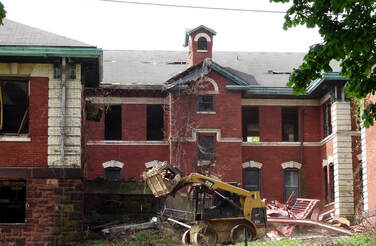 Demolition of Overbrook Asylum Demolition of Overbrook Asylum
In 1917, one of the most infamous events occurred at the Overbrook Asylum. The boilers stopped working leaving the inmates without heat for 20 days during the winter. Twenty-four persons died of the cold, many freezing to death in their beds.
Annie Hinkel would end up institutionalized again, and died in 1935 at age of 51 at the State Asylum in Monmouth, New Jersey. As the years passed the Overbrook became derelict, and in 2007 a new site was purchased. During its 100-plus years of taking in patients, about 10,000 people died under its roof, most of them of natural causes. The entire complex, which had tunnels connecting all the buildings was demolished in 2018, and new townhouses were built on the land. The identity of the woman's charred skeleton found in the attic was never resolved, and whether she was the unfortunate Catherine Lindner who was murdered remains a mystery.
0 Comments
Your comment will be posted after it is approved.
Leave a Reply. |
Stranger Than Fiction StoriesM.P. PellicerAuthor, Narrator and Producer Archives
July 2024
Categories
All
|
Stories of the Supernatural
- Stories of the Supernatural
- Miami Ghost Chronicles
- M.P. Pellicer | Author
- Stranger Than Fiction Stories
- Eerie News
- Supernatural Storytime
-
Astrology Today
- Tarot
- Horoscope
- Zodiac
-
Haunted Places
- Animal Hauntings
- Belleview Biltmore Hotel
- Bobby Mackey's Honky Tonk
- Brookdale Lodge
- Chacachacare Island
- Coral Castle
- Drayton Hall Plantation
- Jonathan Dickinson State Park
- Kreischer Mansion
- Miami Biltmore Hotel
- Miami Forgotten Properties
- Myrtles Plantation
- Pinewood Cemetery
- Rolling Hills Asylum
- St. Ann's Retreat
- Stranahan Cromartie House
- The Devil Tree
- Trans-Allegheny Lunatic Asylum
- West Virginia Penitentiary
- Paranormal Podcasts
"When misguided public opinion honors what is despicable and despises what is honorable, punishes virtue and rewards vice, encourages what is harmful and discourages what is useful, applauds falsehood and smothers truth under indifference or insult, a nation turns its back on progress and can be restored only by the terrible lessons of catastrophe."
- Frederic Bastiat
- Frederic Bastiat

Copyright © 2009-2024 Eleventh Hour LLC. All Rights Reserved ®
DISCLAIMER
DISCLAIMER
 RSS Feed
RSS Feed
















